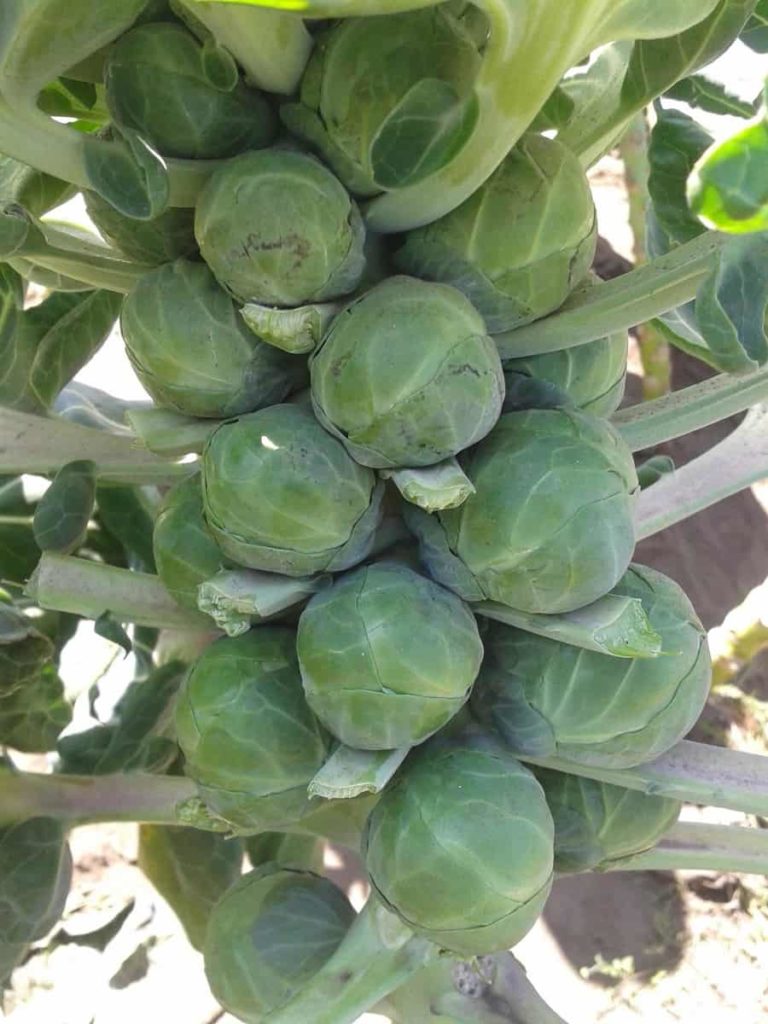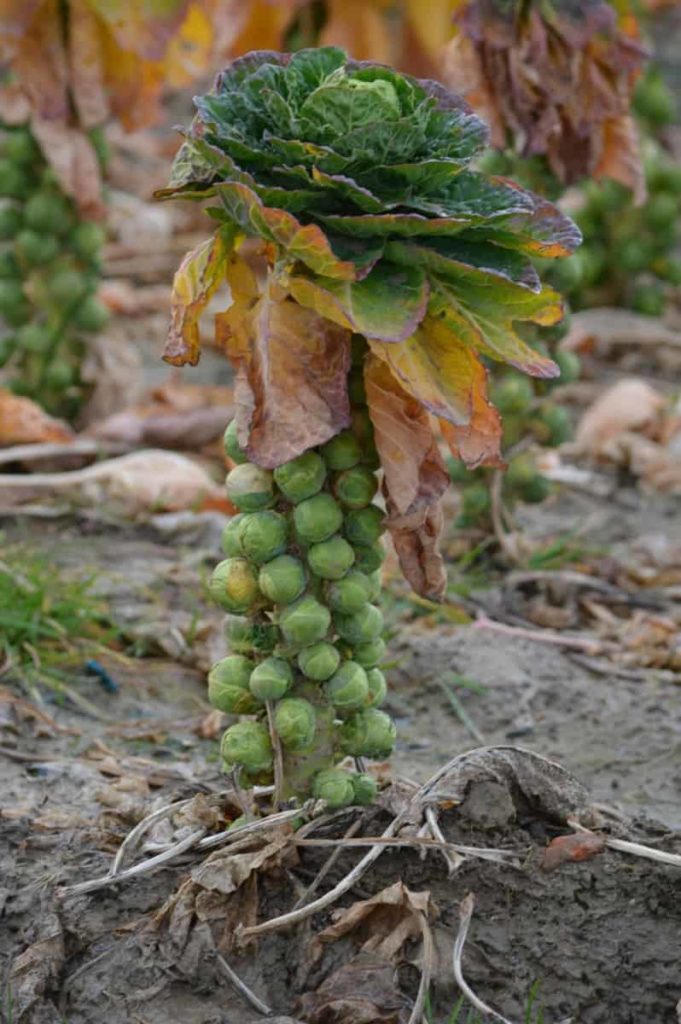Brussels Sprouts are a fall crop that needs cold weather. Like any other plant, they are part of pests and diseases you will need to deal with. Sometimes the vegetable will go to seed early before getting the chance to prepare a good head. And while it’s a cool-weather vegetable, it’s not easy to grow it in winter.
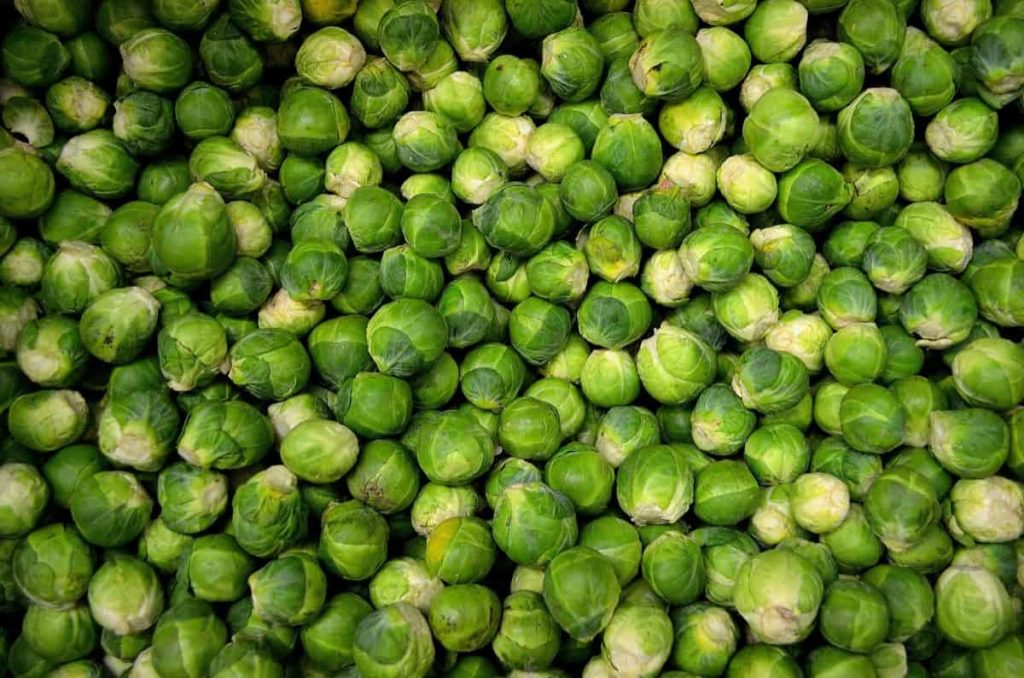
But for the sake of delicious and juicy vegetables, they can tackle all the growing problems. It is easy to fix the most common problems you may face when growing Brussels Sprouts. Let’s check out 19 common Brussels Sprouts plant problems below.
19 common Brussels Sprouts plant problems
Loose leaved Sprouts
Like all the brassicas, Sprouts also need to be firmly planted. Loose sprouts are a condition that makes the head of your Brussels Sprouts bud badly. Brussels has a poor head but also loose leaves. The common reason for this is poor soil, lack of growth, and especially the use of non-hybrid cultivars. The only hybrid cultivar can be relied upon to produce firm Sprouts.
Although the cultivation of Brussels Sprouts is not difficult, they give heavy food and require extra fertilization to grow well. Another reason for loose leaves is the hot weather conditions. Ideal for Brussels Sprouts is cold weather. Scorching temperatures will lead to a bad head.
Solution – Ensuring that the plant has a lot of nutrients can also help fight a loose-leafed, poorly formed head-producing in hot weather. Work in compost or manure in the soil where you plan to plant your Brussels Sprouts. You can trim the plant’s upper part; it will help send energy back to the heads. With a slight change in your Brussels Sprouts care, it will be possible to grow Brussels Sprouts whose leaves are not loose, poorly formed heads.
Not many Sprouts
The number of leaves in your plant will determine how many Sprouts it grows. That is why it is very important to ensure that your plant has proper conditions from the very beginning. Inadequate water, sunlight, soil fertility, or temperature can all help not produce many leaves in the plant.
Solution –Ensure the use of fertile soil. Add some compost or other nutrient supplements to the soil to ensure that the plant will be sufficient for the entire growing period. This problem is not easily solved when it makes itself clear. Prevention is the only way you can use to prevent the plant from producing enough Sprouts.
Falling over
Brussels Sprouts grow quite tall, which means they can fall. The main reason for their fall is that you did not plant them deep enough in the place.
Solution – Whether you have sown seeds directly or transplanted seedlings in the garden, you need to ensure the roots are completely covered and anchor the plant. Make up the dirt by about 6 inches by the end of summer, and it should be strong for the rest of the growing season. Look at the seed catalogs for small Brussels Sprouts plants. Some species are not that tall and are less likely to fall.
Failure to germinate
Check the growing bed if your Brussels doesn’t poke head out of the soil a month after sowing Brussels Sprouts. Cabbage maggots are famous for tunneling into the roots and eating their best of them.
Solution – These maggots will mature into cabbage root flies. Hot temperatures and dry soil help reduce their numbers. You can also plant Garlic, Chives, Mint, and leeks as companions to prevent them.
Weak-looking plants
Seedling’s stems are brown and wilt, causing leafy heads to fall. Then you’re probably dealing with the damping-off disease. It is caused by a fungi pathogen that thrives in perfectly cold, wet soil.
Solution – If you are starting seeds indoors, make sure your planting pots have been sterilized. Additionally, use only sterile potting soil mix and water with hot water. You can also use hot, diluted garlic tea to water your seedlings. It will eliminate germs by keeping your seedlings hydrated.
Seedlings are cut on the soil surface
Grubs lie below the ground surface and cut their way through the stems. Your plants will look like someone has scythed them down at their bases.
Solution – Sprinkle wood ash around the plant base. Moreover, making cardboard collars for your plant trunks can help. Cut the toilet paper rolls into half crosswise, then in length, and tape them around the trunks.
Bolting
Bolting is the most common Brussels Sprouts problem. It is a condition through which the blossoms and seeds start to grow. It is due to Brussels experiencing temperatures below 10°C for a long time. Brussels Sprouts with hollow stems can also cause bolting, preventing proper nutrient and moisture exchange.
Solution – The solution to bolting is to plant Brussels Sprouts quite quickly. Another one is choosing Brussels Sprouts, which are bolting resistant.
Growing Brussels Sprouts Hydroponically – Full Guide
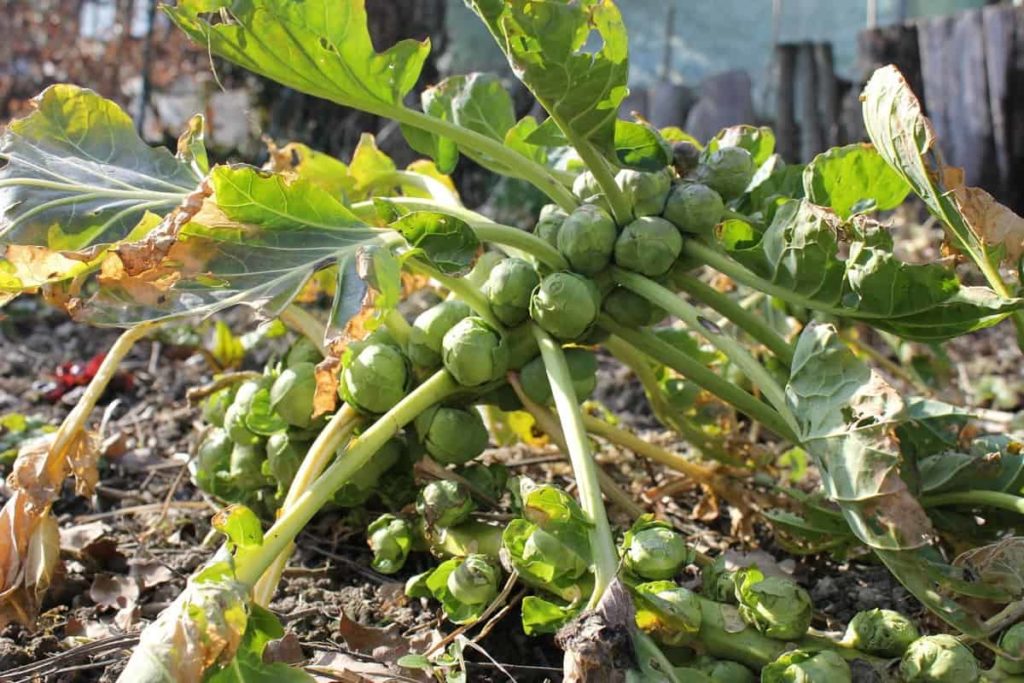
Brown Leaves
Brussels Sprouts are prone to a shortage of boron.
Solution – Stir some borax in compost tea to boost their nutrition. Then make sure the same borax works in next year’s compost before modifying the soil for next season’s plantation. Remember that these Sprouts are heavy feeders. The best soil for them is strong enough but well-drained, heavy in nitrogen, and low in phosphorus.
Diseases
Bacterial leaf spot
The disease looks like black or purple spots on the leaves outside the plant. Spots usually have yellow circles around them.
Solution – To avoid this disease, do not use overhead watering. If a plant is suffering from disease, dispose of it so that it does not affect other plants. Next year, if the infection goes out of control, do not plant Brussels Sprouts to eliminate the infection.
Black rot
Black rot does not look black from the outside. The disease is transmitted through water, so you should avoid overhead water even if you do not see symptoms of infection.
Solution – An infected plant can also spread bacteria by its seeds, so you need to remove the plant before it goes into the seed. Next season, avoid planting in the affected area, as the disease can stay on other crops such as Turnips, Radish, and other cole vegetables.
Brussels Sprouts Growing Tips in the Backyard
Turnip mosaic virus
Aphids transfer viruses from plant to plant. It will affect the leaves of the Brussels Sprouts plant and develop yellow or brown colors.
Solution – Since the aphids are the culprits that spread the virus, you will need to eliminate all the aphids and prevent them from getting close to your crops. Keeping the aphids away from your Brussels Sprouts is best to control the virus. You should grow your plants under-screen cover to prevent the aphids from entering. Pesticides are a way to eliminate them, but covering them will be the easiest prevention measure if you prefer a more organic approach.
Downy mildew
Small angled wounds on the upper surface of leaves that grow in orange or yellow necrotic spots. White-floppy growth under the leaves. Cold, moist conditions favor the appearance of the disease.
Solution – Remove all crop debris after harvesting; rotate with non-brassicas; it is possible to control the downy mildew on Brussels Sprouts by applying proper fungicides.
Fusarium wilt
Yellow-green discoloration of leaves and stunted growth of plants; lower leaves turn into yellow-brown necrotic areas and fall from the plant. Brown and defoliation spread upwards from the bottom of the plant; more pronounced on symptoms from the other side of the leaf.
Solution – Plant-resistant species. Most other control methods become ineffective after the disease has emerged; disinfecting the devices can prevent the spread.
Growing Bean Sprouts Tips, Ideas, Techniques

Powdery mildew
Small white spots on upper and lower leaf surfaces can also show purple blotching. Patches combine to form a dense powdery layer that coats leaves; leaves become chlorotic and fall off the plant. The appearance of the disease is preferred due to dry weather, moderate temperature, low humidity, and low rainfall levels.
Solution – Plant-resistant species, rotating crops, removing all crop debris after harvest, avoiding overuse of nitrogen fertilizer that encourages the growth of powdery mildew; using a sulfur spray, dust or vapor can control powdery mildew.
Pests
Cabbage looper
The caterpillars are yellow-green with white lines running down either side of their body, and They make large or small holes in leaves.
Solution – Natural enemies generally control looper populations. You can handpick larvae if they become troubled larvae. The organically acceptable control method is the application of Bacillus thuringiensis, which effectively kills young larvae. Chemical sprays can harm the population of natural enemies and should be chosen carefully.
Flea beetle
Small holes in leaves. Flea beetles can reduce plant growth if severe. It can kill the plant. Small plants are more prone to Flea beetle damage than older plants; older plants can tolerate infection, and flea beetles may occur in nearby weed species, plant debris, or soil in winter.
Solution – In areas where flea beetles are a problem, floating row cover may have to be used before beetles emerge to provide a physical barrier to protect small plants. Trap crops can provide a measure of control – cruciferous plants are Excellent. Using thick mulch layers can help prevent beetles from reaching the surface. Diamotecoeus earth is an effective control method for organic farmers.
Cabbage worms
Cabbage worms are four different butterflies or moths: small whites, cabbage loopers, cabbage webworms, and diamondback moths. The caterpillars are usually thick and green and can be found on cole vegetables, including Brussels Sprouts.
Solution – Birds, paper wasps, and yellow jackets are all-natural predators of cabbage worms. If you let these critters move around your garden, they may be able to help you reduce the cabbage worm population. You can also handpick the worms from Brussels Sprouts, but it’s possible that if it’s your only way of control, you may miss something.
Try covering plants with row cover to keep moths and butterflies away from their crops. Another option is to use intercropping for your benefit. Red leafed cole crops are not so desirable for butterflies, and aromatic herbs like Sage or Oregano can repel butterflies.
Soil Preparation for Garlic Plants: Best Soil Mix, pH, Compost, and Recipe
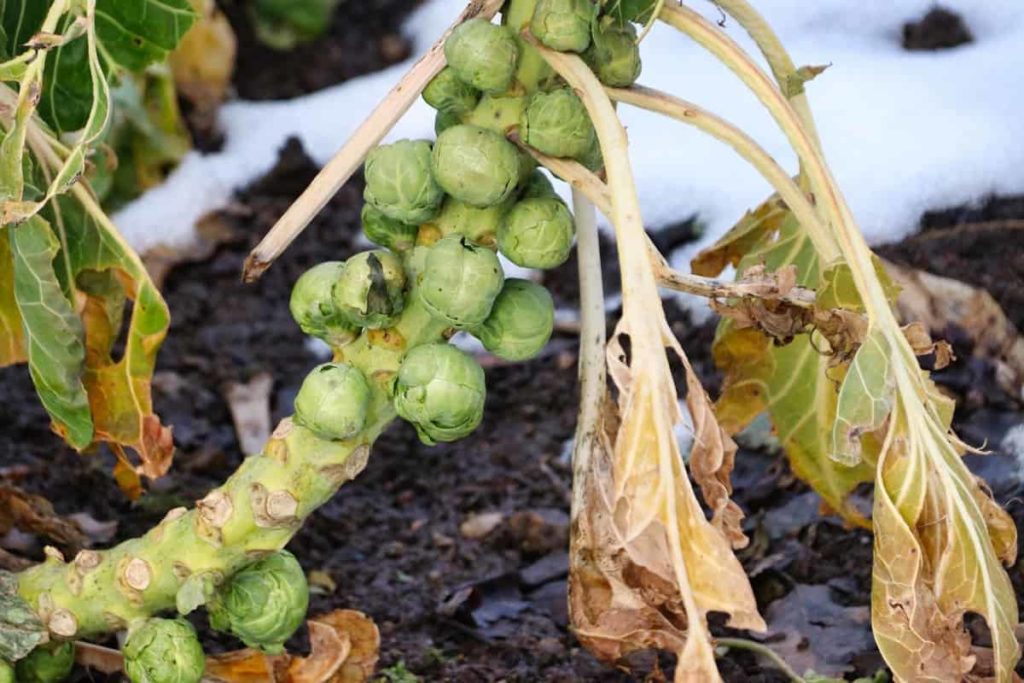
Thrips
If the population is large, the leaves can be distorted; the leaves are covered in dense stippling and look silver.
Solution – Use reflective mulch early in the growing season to prevent the thrips. Apply proper pesticide if the thrips become annoying.
Root-knot nematodes
The galls can appear as quickly as they can a month before planting; nematodes prefer sandy soil, and the field or garden areas with this type of soil are most likely to suffer damage. Solution – Plant resistant species if nematode is present in the soil. If symptoms indicate nematodes check plant roots mid-season or early. You can reduce the level of nematode population in the soil by Solarizing.
- Broccoli Seed Germination and Selection
- Asparagus Seed Germination and Variety Selection
- Seasonal Flower Gardening: Best Practices for Spring, Summer, Fall, and Winter
- How to Grow Hibiscus from Flower
- Plantation Ideas for Home Decoration: A Beginners Guide
- Flower Garden Designs and Layouts for Beginners
- Planting and Spacing Techniques in Papaya: A Beginner’s Guide
- Growing Gold: Essential Techniques for Planting Pineapples
- How to Make Kalanchoe Plant Bushy: Home Remedies and Solutions
- 11 Reasons Why Your Gardenia is Not Blooming: Home Remedies and Solutions
- Eco Elegance: The Guide to Designing a Drought-Tolerant Landscape
- Gardening on a Slope: Strategies for Hillside Landscaping
- Nourish and Flourish: Top Organic Mulches for Thriving House Plants
- Everything You Want to Know about Indian Mogra Flower: Discover Uses and Growing
- Green Thumb Success: Expert Tips for Cultivating Greenhouse Pumpkins All Year Round
- Maximize Growth & Flavor: The Ultimate Guide to Companion Planting in Herb Gardens
- How to Control Rhododendron Problems Naturally: Home Remedies and Organic Ways to Fix Them
- Natural Magic: The Remarkable Benefits of Cinnamon for Plants
- Best Steps to Revive Dying Tulip with Natural and Organic Treatment
- 10 Reasons Why Your Angel Trumpet is Not Blooming: Remedies and Treatment
- How to Fix Periwinkle Leaf and Flower-Related Problems: Natural Remedies and Solutions
- How to Fix Zinnias Leaf and Flower Problems: Discover Natural and Home Remedies
- Organic Steps to Induce Lemon Tree Flowers: A Comprehensive Guide
- Bloom Booster: Crafting the Perfect Homemade Bougainvillea Fertilizer
- Optimizing Growth: A Guide to Applying NPK Fertilizer for Potted Plants
- 10 Best Homemade Fertilizers for Rubber Plant: DIY Recipes and Application Method
- How to Boost Female Pumpkin Flowers: Effective Steps for More Flowers and High Yields
- Transform Your Indoor Garden: Top Benefits of Pink Salt for Houseplants
- 10 Best Homemade Fertilizers for Peacock Plants (Calathea): Easy DIY Guide
- Unlock Blooms: 9 Reasons Why Your Potted Chrysanthemum is Not Blooming
- 8 Reasons Why Your Potted Hibiscus is Not Blooming: Fix it with Simple Solutions
- Unlock Blooms: 9 Key Reasons Your Potted Frangipani Won’t Flower
- 10 Reasons Why Is My Ice Plant Not Blooming: Remedies and Treatment
- 10 Reasons Why My Potted Hydrangea Not Blooming: Treatment and Remedies
- 10 Reasons Why is My Wisteria Not Blooming: Remedies and Treatment
- 10 Reasons Why is My Goldfish Plant Not Blooming: Remedies and Treatment
